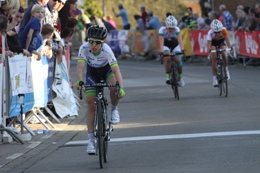11 November 2014
 Professional road cyclist Amanda Spratt will join this weekend’s Ride for Pain in the Adelaide Hills, knowing perhaps more than most what it takes to push through pain barriers.
Professional road cyclist Amanda Spratt will join this weekend’s Ride for Pain in the Adelaide Hills, knowing perhaps more than most what it takes to push through pain barriers.
The Orica-AIS rider, who won silver in the women’s team time trial at the UCI Road Cycling World Championships in Spain in September, suffered chronic pain for six years early in her career.
“I endured six years of pain that resulted from a sciatic nerve problem that wasn’t treated correctly and finally resulted in surgery and lengthy rehabilitation,” Spratt says.
“During this time I had endless hours of doctor visits, physio appointments and working with various specialists including (Ride for Pain brainchild) Professor Lorimer Moseley to try to overcome and beat this pain. I still have a level of pain even today, but it is something that I am now able to manage.”
The 27-year-old has had a successful past couple of years, based in New South Wales and competing successfully across Australia and internationally throughout Europe. She says being a professional cyclist requires a high pain threshold.
“To be the best, you have to be able to push yourself to the limit,” she says.
“That dizzy and sick feeling is not uncommon, but is something that accompanies the pain of getting through a tough session or race. It’s all about pushing yourself to the brink, challenging yourself and feeling the satisfaction of achieving something you weren’t sure you could.”
This Sunday, Spratt will take on the Ride for Pain’s six hour ride with 2470 metres of tough ascent.
“What better way to endure that pain than to be able to share it with other riders,” she says.
“This event is a great opportunity to get out there and challenge yourself to see what you are capable of. There are rides to cater for different abilities so everyone can have a go.
“I think the Ride for Pain is a great community event that allows anybody to challenge themselves to push through that pain barrier and a great way to raise awareness of chronic pain within the community.
“It’s a health issue that almost everyone can relate to, whether it’s a friend, a family member or work colleague, yet it doesn’t get the same exposure and attention of other health issues, so to be able to raise awareness is fantastic.”
Spratt says cyclist and driver road safety is another important issue which Ride for Pain can raise awareness for.
“Cycling is becoming more and more popular in Australia and being able to gain respect between cyclists and motorists is an ongoing issue,” she says.
“Raising awareness of cyclist and driver road safety is an important issue and one that affects us every day we swing our leg over the bike and head out for a ride.”
This year’s Ride for Pain is supported by Pain Adelaide partners: UniSA, the University of Adelaide, Flinders University, the Motor Accident Commission, WorkCoverSA and Pfizer.
The Motor Accident Commission (MAC) is involved as part of its role in reducing road trauma throughout South Australia. MAC is responsible for both the state’s road safety communication program and Compulsory Third Party (CTP) scheme.
MAC General Manager Road Safety Michael Cornish says the partnership provides an opportunity to share MAC’s Be Safe Be Seen cycling safety program through the ride.
“Be Safe Be Seen encourages safer riding practices by promoting techniques to improve road positioning, defensive riding and visibility,” Mr Cornish says.
“It shares messages targeting drivers to encourage them to look carefully for riders and raise awareness of cyclist vulnerability.”
For more information and to register, please visit www.rideforpain.org
Media contact: Kelly Stone office 8302 0963 mobile 0417 861 832 email Kelly.stone@unisa.edu.au


